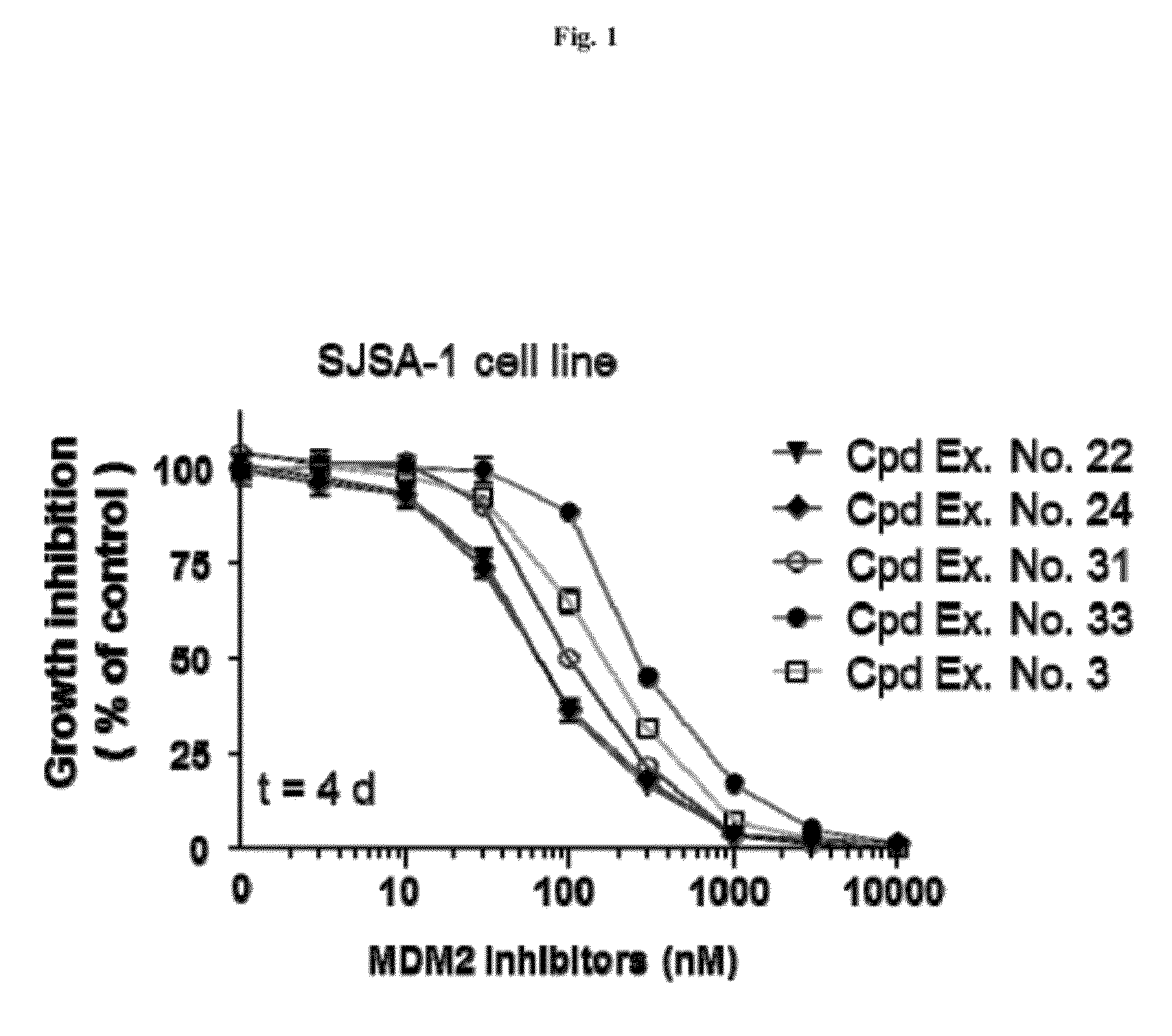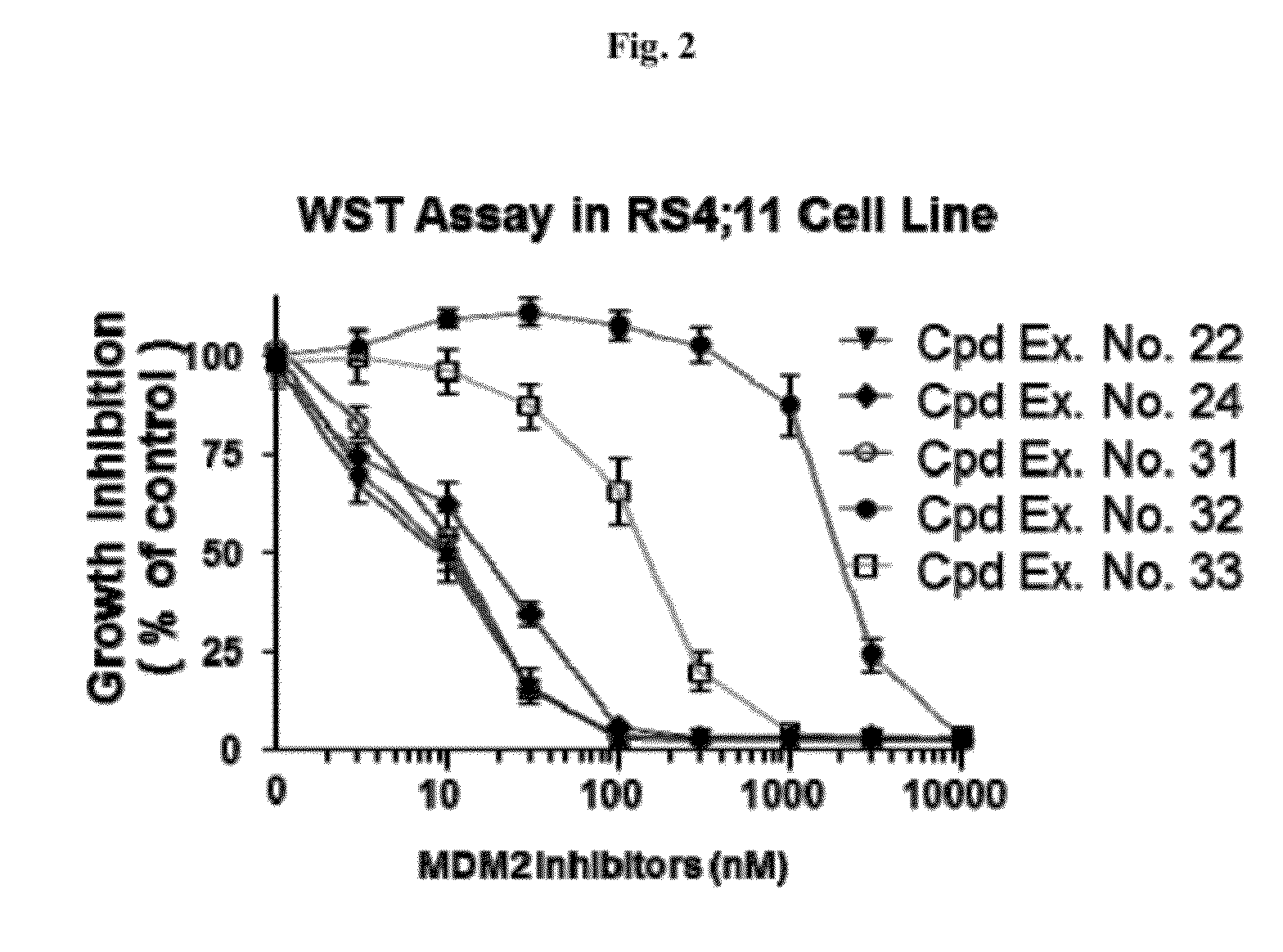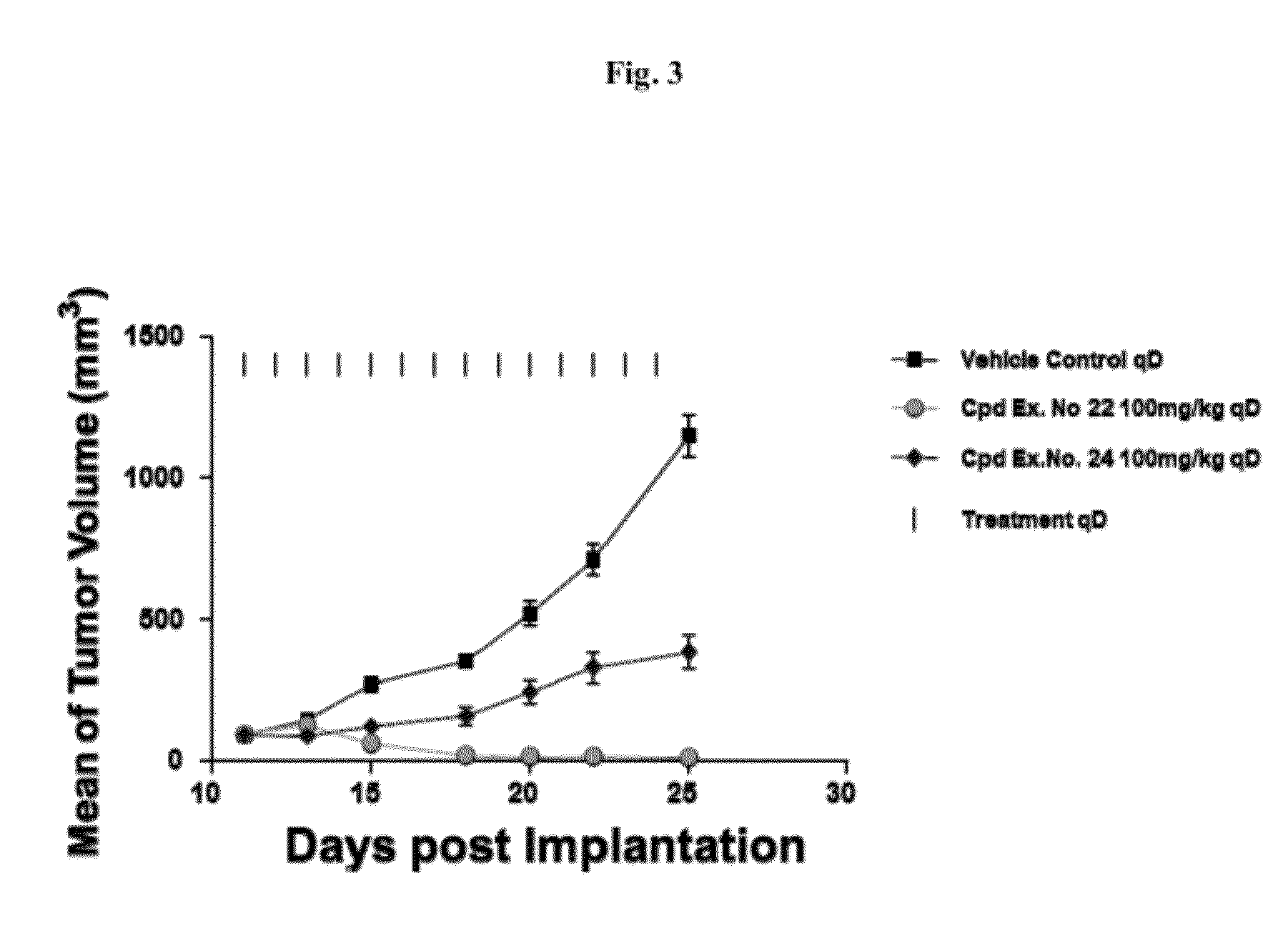Spiro-oxindole MDM2 antagonists
a technology of oxindole and mdm2, which is applied in the field of oxindole mdm2 antagonists, can solve the problems of poor cell permeability, inability to identify potent, non-peptide small molecule inhibitors, and poor cell permeability, and achieve the effect of preventing or meliorating a hyperproliferative diseas
- Summary
- Abstract
- Description
- Claims
- Application Information
AI Technical Summary
Benefits of technology
Problems solved by technology
Method used
Image
Examples
example 1
Synthesis of Compound Example No. 3
[0879]
[0880]3-Chloro-2-fluorobenzaldehyde (6.24 g, 39.4 mmol) was added to a solution of piperidine (3.88 mL, 39.4 mmol) and 6-chlorooxindole (6.0 g, 35.8 mmol) dissolved in methanol (100 mL). After stirring overnight, the resulting solid was filtered and washed with methanol and hexanes to give 10.6 g of (E)-6-chloro-3-(3-chloro-2-fluorobenzylidene)indolin-2-one (3) as a green solid.
[0881]
[0882]Compound 3 (19.5 mmol), (5R,6S)-5,6-diphenylmorpholin-2-one (4) (23.4 mmol), and ketone 5 (39 mmol) were dissolved in THF (7.5 mL) and toluene (75 mL) and refluxed for 3 hours. After cooling to room temperature, the reaction was filtered. The solution was concentrated and purified by column chromatography to give the product (30-50% yield) as a solid.
[0883]
[0884]Trans-4-aminocyclohexanol (1.8 g, 15.6 mmol) was added to a solution of intermediate 6a (1.0 g, 1.56 mmol), dissolved in THF (30 mL), and refluxed overnight. The solvent was removed and the crude pr...
example 2
Synthesis of Compound Example No. 22
[0885]
[0886]Concentrated sulfuric acid (2 mL) was added to a solution of intermediate 6a (3.65 g, 5.69 mmol) dissolved in methanol (50 mL), and the resulting solution was heated to 50° C. for 5 hours. The methanol was removed by evaporation, and the resulting concentrate was cooled to 0° C. and slowly neutralized with a solution of saturated sodium bicarbonate. The aqueous solution was extracted with ethyl acetate and the organic layer was dried over sodium sulfate, filtered, and concentrated. The crude product was purified by column chromatography to give 2.20 g (57% yield) of intermediate 11.
[0887]Intermediate 11 (2.20 g, 3.25 mmol) was dissolved in acetonitrile (25 mL) and THF (5 mL), CAN (3.56 g, 6.50 mmol), and water (25 mL) were added. After 15 minutes, the reaction was quenched with saturated sodium bicarbonate, extracted with ethyl acetate, dried over sodium sulfate, and filtered through celite. The solvent was removed and the crude produc...
example 3
Synthesis of Compound Example No. 23
[0892]
[0893]EDCI (19 mg, 0.097 mmol), HOBt (13 mg, 0.097 mmol), and DIEA (0.034 mL, 0.195 mmol) were added to a solution of carboxylic acid intermediate 13 (30 mg, 0.065 mmol) dissolved in DCM. After 10 minutes, 4-aminotetrahydro-2H-thiopyran-1,1-dioxide hydrochloride (24 mg, 0.13 mmol) and a catalytic amount of DMAP were added. After stirring overnight, the solvent was removed and the crude product was purified by column chromatography to give 15 mg of Compound Example No. 23 as a white solid. The solid was further purified by preparative HPLC, and lyophilized to give 10 mg of Compound Example No. 23 (as the TFA salt) as a white powder. 1H NMR (300 MHz, CD3OD) δ ppm 7.64 (t, J=7.1 Hz, 1H), 7.49 (dd, J=2.1, 8.1 Hz, 1H), 7.41 (t, J=7.5 Hz, 1H), 7.18 (t, J=9.9 Hz, 1H), 7.11 (dd, J=1.6, 8.2 Hz, 1H), 6.79 (d, J=1.6 Hz, 1H), 5.10 (d, J=11.1 Hz, 1H), 4.80 (d, J=11.2 Hz, 1H), 4.10-3.94 (m, 1H), 3.27-2.91 (m, 3H), 2.88-2.74 (m, 2H), 2.35-1.64 (m, 10H), 1....
PUM
| Property | Measurement | Unit |
|---|---|---|
| temperature | aaaaa | aaaaa |
| temperature | aaaaa | aaaaa |
| temperature | aaaaa | aaaaa |
Abstract
Description
Claims
Application Information
 Login to View More
Login to View More - R&D
- Intellectual Property
- Life Sciences
- Materials
- Tech Scout
- Unparalleled Data Quality
- Higher Quality Content
- 60% Fewer Hallucinations
Browse by: Latest US Patents, China's latest patents, Technical Efficacy Thesaurus, Application Domain, Technology Topic, Popular Technical Reports.
© 2025 PatSnap. All rights reserved.Legal|Privacy policy|Modern Slavery Act Transparency Statement|Sitemap|About US| Contact US: help@patsnap.com



